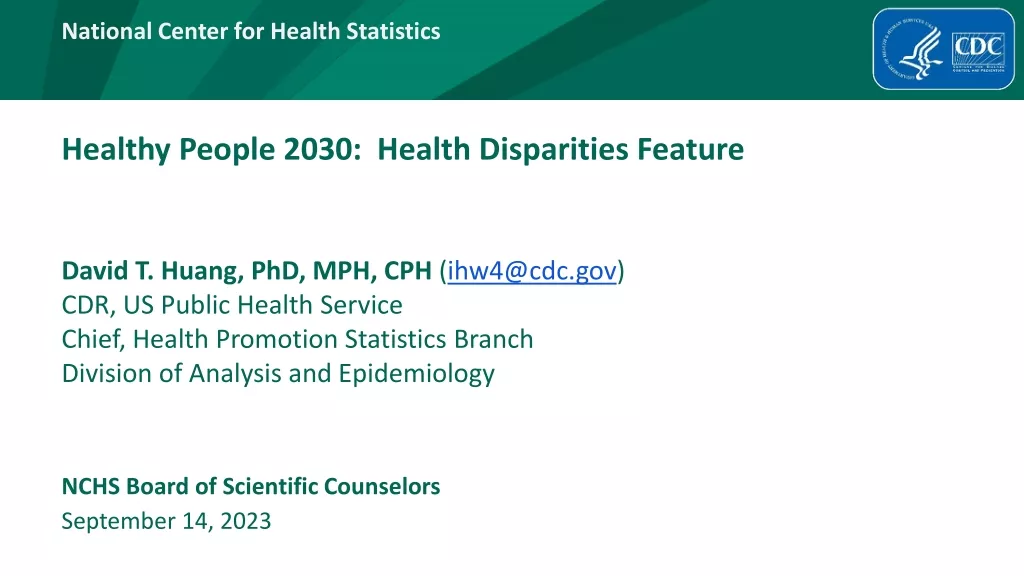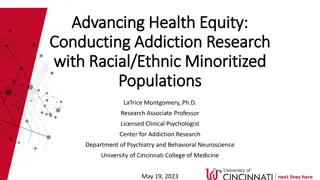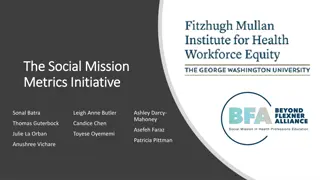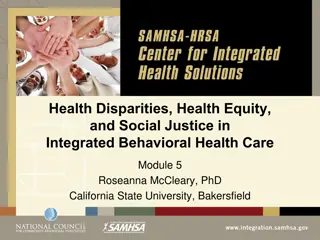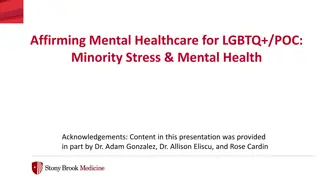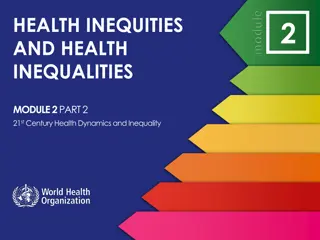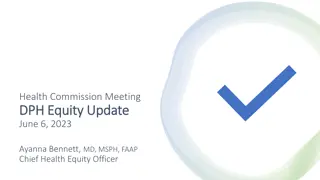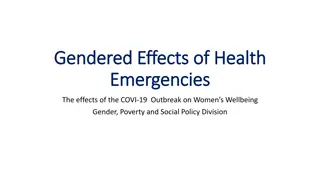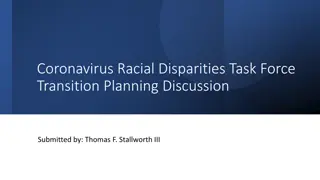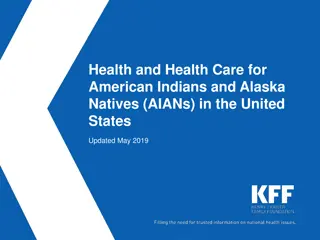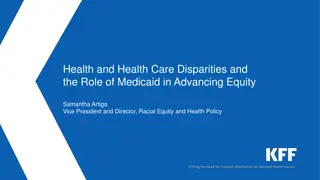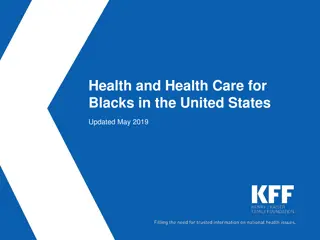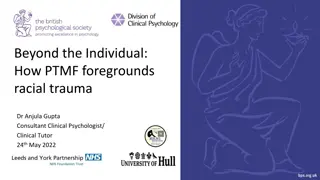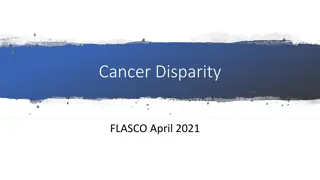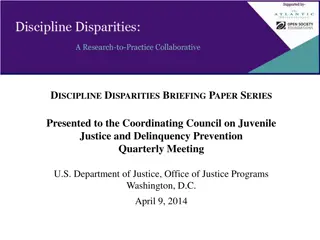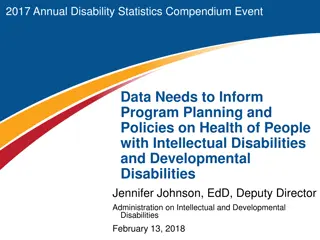Addressing Health Disparities Through Case Narratives
This presentation explores health disparities through case narratives, focusing on the impact on healthcare providers and patients. Learn to identify, understand, and reflect on attitudes towards disparities in health care. Topics include types of disparities, financial relationships, and learning objectives for recognizing disparities.
Download Presentation

Please find below an Image/Link to download the presentation.
The content on the website is provided AS IS for your information and personal use only. It may not be sold, licensed, or shared on other websites without obtaining consent from the author.If you encounter any issues during the download, it is possible that the publisher has removed the file from their server.
You are allowed to download the files provided on this website for personal or commercial use, subject to the condition that they are used lawfully. All files are the property of their respective owners.
The content on the website is provided AS IS for your information and personal use only. It may not be sold, licensed, or shared on other websites without obtaining consent from the author.
E N D
Presentation Transcript
Teaching Health Disparities using Case Narratives February 24, 2021 BODE ADEBAMBO, MD ASSOCIATE PROFESSOR DEPARTMENT OF FAMILY MEDICINE ADAM T. PERZYNSKI, PHD ASSOCIATE PROFESSOR OF MEDICINE AND SOCIOLOGY DEPARTMENT OF MEDICINE THE METROHEALTH SYSTEM/CWRU
Health Disparity The original work was supported in part by a Bureau of Health Professions Grant, Faculty Development for Primary Care (James Campbell MD, Principal Investigator) 2011 - 2016 HRSA: D55HP23193
I disclose I have the following financial relationship: B Adebambo I have a royalty agreement with Springer Publishing for a book on Health Disparities.
I disclose the following financial relationships: A Perzynski I am co-founder and Chief Science and Strategy Officer of Global Health Metrics, LLC, a Cleveland-based startup software company. I have a royalty agreement with Springer Publishing for a book on Health Disparities. I have a royalty agreement with Taylor Francis for a book about Structural Equation Modeling.
Learning Objectives 1. The learner will identify the health disparities represented in the case narrative. 2. The learner will understand how the health disparities represented in this case affect those seeking and providing health care. 3. The learner will identify their own attitudes towards health disparities using a self-reflection tool.
Health Disparity A particular type of health difference that is linked with social, economic or environmental disadvantage Healthy people 2020
Health Disparity vs Health Care Disparity Health disparity refers to a higher burden of illness, injury, disability, or mortality experienced by one population group relative to another. A health care disparity typically refers to differences between groups in health insurance coverage, access to and use of care, and quality of care
Conceptual Framework: Disparities, Differences, and Discrimination A difference in health care is the simple unadjusted difference in means or rates between racial/ethnic groups. E.g: Health status differences between the groups may explain some of the difference in health care use. Latino patients may have fewer health problems, perhaps because they are younger, and require fewer visits or worse health among the elderly compared with young adults. Differences in use because of health status are not considered part of a disparity, nor are those because of different preferences for health care treatment Discrimination treating a group of people different from another IOM Unequal treatment
Health Disparities Adversely affects groups of people Health care disparities occur in the context of broader inequality. Avoidable differences (WHO) Mostly related to social determinants of health (WHO) There are many sources across health systems, providers, patients and managers that contribute to disparities. Bias, stereotyping, prejudice and clinical uncertainty contribute to disparities.
MOST CURRENT SDOH EFFORTS IN US HEALTHCARE ARE FOCUSED HERE! Health Inequality From National Health Service, Scotland
Health Disparity Related to Health outcomes Overall quality of care and population health. (WHO USA 37) Social Justice Increased medical care expenditure (Centers of political and economic studies b/w 2003 2006 saved 229.4 billion) About 30% direct cost due to health inequities Indirect premature death and loss of work
Health Equity Health equity benefits everyone . Every person who dies young, is avoidably disabled, or is unable to function at their optimal level represents not only a personal and family tragedy but also impoverishes our communities and our country. We are all deprived of the creativity, contributions, and participation that result from disparities in health status. CDC 2013 health disparities/inequality report
Conceptual Model of Social Determinants of Health @atperzynski
SDoH Race/ethnicity Safe and affordable housing Gender Community Planning Mental health Religion Sexual orientation SES Language/literacy Disability Education Healthy food Transportation
The level of individual social needs is staggering in Northeast Ohio Figure 1. Percent with Social Needs by Age Cohort at the MetroHealth Study Site in 2020. N=16088 Social Isolation Food Insecurity High Daily Stress No Internet Connectivity Transportation Insecurity Financial Strain Housing Insecurity Domestic Abuse Age Total 44 33 21 20 17 12 8 4 0-24 52 42 23 12 20 12 8 9 25-34 51 30 21 4 15 10 10 7 35-54 47 39 28 9 19 16 11 6 55-64 41 37 22 22 19 14 7 3 65+ 35 22 12 36 13 7 3 1 Data Provided by MetroHealth Institute for HOPE
Infant mortality rates by race/ethnicity: Cleveland, 2011- 2013 Average
Reflection tool How has learning about health disparities today affected the way you will provide health care in the future? Describe the importance of being sensitive to the needs of diverse patients. Please write any additional thoughts you have about the narrative(s) or health disparities.
ACGME Milestones Family Medicine PC-3: Partners with the patient, family and community to improve health through disease prevention and health promotion; PROF-3: Demonstrates humanism and cultural proficiency Internal Medicine PROF-3: Responds to each patient s unique characteristics and needs; ICS-1: Communicates effectively with patients and caregivers
Evaluation Form Levels Patient narratives evoke strong feelings. Health disparities occur more frequently than health care providers think about. Patient narratives are important for learning about health disparities. Some patients might feel the health care system is indifferent to their needs. Patient narratives help me think about what patients might be going through. I am ready to implement practice changes that reduce disparities. I am confident in my ability to care for people from diverse backgrounds. I am confident in my abilities to lead an effort to address disparities at my institution. PLEASE CIRCLE YOUR ANSWER FM Prof 3 Neither Disagree or Agree 3 3 3 Strongly Disagree Strongly Agree Question / Statement Disagree Agree Before After 1 1 1 2 2 2 4 4 4 5 5 5 1 Before 2 After 1 2 3 4 5 Before 1 2 3 4 5 3 After 1 2 3 4 5 Before 1 2 3 4 5 3 After 1 2 3 4 5 Before 1 2 3 4 5 3 After 1 2 3 4 5 Before 1 2 3 4 5 4 After 1 2 3 4 5 Before 1 2 3 4 5 4 After 1 2 3 4 5 Before 1 2 3 4 5 5 After 1 2 3 4 5
Conclusion Health providers are in a position to affect positive change and reduce health disparities. It is important we not only provide information and awareness but also challenge reflective and critical thinking in the individual learners. The use of case narratives is an effective mechanism to improve provider confidence and encourage active action to reduce disparities.
References IOM Unequal Treatment: Confronting Racial and Ethnic Disparities in Health Care U.S. Department of Health and Human Services. The Secretary s Advisory Committee on National Health Promotion and Disease Prevention Objectives for 2020. Phase I report: Recommendations for the framework and format of Healthy People 2020. Section IV. Advisory Committee findings and recommendations. Available at: http://www.healthypeople.gov/hp2020/advisory/PhaseI/sec4.htm#_Toc211942917. Accessed 1/6/10. CDC Health Disparities & Inequalities Report United States, 2013, Morbidity & Mortality Weekly Report (MMWR) Supplement, November 22, 2013, Vol.62, Supplement No. 3, pg.1-187 2012 National Healthcare Disparities Report, U.S. Department of Health and Human Services, Agency for Healthcare Research and Quality, AHRQ Publication No. 13-0003 May 2013, http://www.ahrq.gov/research/findings/nhqrdr/index.html
References, cont. The effect of race and sex on physicians recommendations for cardiac catheterization. Schulman, k. et al NEJM Feb 25, 1999 pg 618-626 A quality Improvement Framework for Equity in Cardiovascular Care: Results of a National Collaborative Journal of Healthcare Quality. Siegal et al Vol.34, No 2, pp.32-43 Centers for Disease Control and Prevention. CDC health disparities and inequalities report United States, 2011. MMWR 60(Suppl):1 116. 2011.
References Implicit Bias in health care professionals: a systemic review. Fitzgerald and Hurst. BMC Medical Ethics (2017) 18:19 Racism and Health: Pathways and Scientific evidence. David Williams and Selena Mohammed Am Beh Scientist 2013, 57(8) 1152-1173 Helping Medical Learners recognize and Manage unconscious bias toward certain patient groups. Teal CR, Coll AC Med Educa 2012 Jan; 46(1): 80
References Continued CDC Health Disparities and Inequalities Report United States 2011 www.cdc.gov/mmwr/pdf/other/su6001.pdf Journal of Health Care for the poor and Underserved . Vol. 9, No. 2 1998. Tervalon, Melanie and Murray-Garcia Jann Stories lives tell: narrative and dialogue in education. Witherel, C., Nodding, N. (Eds) New York. Teacher's College Press. 1991. Narrative Analysis; qualitative research methods. Riessman, Catherine Kohler, Sage Publication. 1993. Use of retrospective pre/post assessments in faculty development. McLeod, P. J., Steinert, Y., & Snell, L. (2008). Medical education, 42(5), 543-543.


